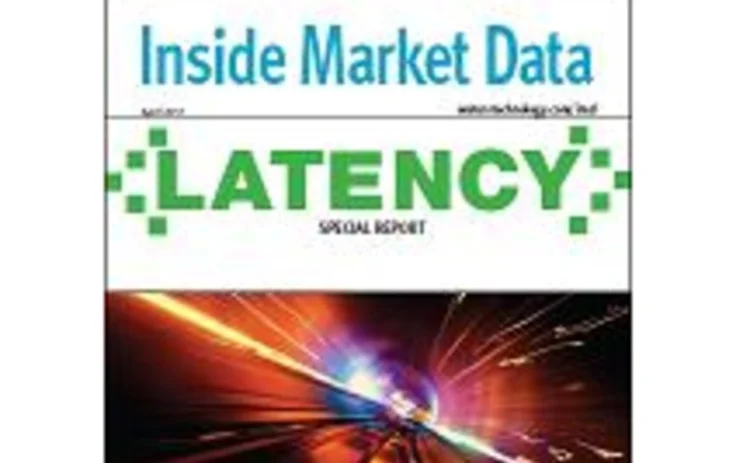Latency special report

Click here to download the PDF
Speed Is Nothing Without Control
Since trading firms first realized there was an advantage to be gained by being able to capture market data and trade faster than their rivals, an arms race has been underway to see who could engineer the fastest and most efficient trading infrastructure with as little latency as possible.
First, firms turned to direct datafeeds, captured using low-latency ticker plants, encouraging exchanges to distribute their feeds even faster. Then firms implemented low-latency messaging layers to distribute that fast data throughout their organizations, which in turn placed pressure on vendors to streamline their technology and eliminate even the slightest trace of latency. This turned the industry's attention to hardware-based technologies that function faster than software, and eliminating network layers altogether by moving trading servers into proximity hosting datacenters close to exchanges, and ultimately into the same facilities as exchange matching engines, spawning a wave of megadatecenters, such as those being built by NYSE Euronext, CME Group and the Singapore Exchange.
But as low latency becomes ever-more important, it also becomes harder to achieve. Saving milliseconds a few years ago was easier than saving microseconds or nanoseconds today, and firms are using sophisticated timestamping and measurement tools to monitor latency at the most granular level possible-in some cases, allowing them to generate microsecond improvements overall by eking out nanoseconds here and there. In addition, firms looking for end-to-end views of latency are also demanding transparency into the delays introduced by links in the chain outside of their control, such as trading venues themselves, prompting exchanges to roll out their own latency monitoring solutions, to provide members with statistics such as order-to-trade and tradeto- tape latency, and where a firm's overall roundtrip latency stands in relation to its peers.
Simply put, those who can't measure their performance can't perform, and will have to look elsewhere for trading advantage. But how long can it be before latency is exhausted as a competitive differentiator? Ultimately, this arms race is limited by light speed and the laws of physics. And perhaps in turn, those firms that can't compete on latency will have the upper hand when the rest of the industry gives up battling over picoseconds and femtoseconds. But according to the participants in this report, there's still a long way to go before we need to worry about that.
Only users who have a paid subscription or are part of a corporate subscription are able to print or copy content.
To access these options, along with all other subscription benefits, please contact info@waterstechnology.com or view our subscription options here: https://subscriptions.waterstechnology.com/subscribe
You are currently unable to print this content. Please contact info@waterstechnology.com to find out more.
You are currently unable to copy this content. Please contact info@waterstechnology.com to find out more.
Copyright Infopro Digital Limited. All rights reserved.
As outlined in our terms and conditions, https://www.infopro-digital.com/terms-and-conditions/subscriptions/ (point 2.4), printing is limited to a single copy.
If you would like to purchase additional rights please email info@waterstechnology.com
Copyright Infopro Digital Limited. All rights reserved.
You may share this content using our article tools. As outlined in our terms and conditions, https://www.infopro-digital.com/terms-and-conditions/subscriptions/ (clause 2.4), an Authorised User may only make one copy of the materials for their own personal use. You must also comply with the restrictions in clause 2.5.
If you would like to purchase additional rights please email info@waterstechnology.com
More on Trading Tech
FCA eyes equities tape, OpenAI and Capco team up, prediction markets gain steam, and more
The Waters Cooler: More tokenization, Ediphy lawsuit updates, Rimes teams up with Databricks, and more in this week’s news roundup.
Buy-side data heads push being on ‘right side’ of GenAI
Data heads at Man Group and Systematica Investments explain how GenAI has transformed the quant research process.
Technology alone is not enough for Europe’s T+1 push
Testing will be a key component of a successful implementation. However, the respective taskforces have yet to release more details on the testing schedules.
MayStreet founder says LSEG abandoned integration in new court filing
In response to LSEG’s motion to dismiss a lawsuit filed by the founder of one of its acquired companies, lawyers for Patrick Flannery have offered more details around communications between MayStreet and the exchange group.
As outages spread, it’s time to rethink how we view infrastructure technology
Waters Wrap: First AWS and then Azure. And these are only the most recent of significant outages. Anthony says a change is needed when it comes to calculating server migrations.
LLM firms come for finance, BMLL gets bought, LSEG users get Preqin feeds, and more
The Waters Cooler: Tradeweb completes fully electronic RFM swaptions trade, IBM cashes in on digital asset mania, and more frights and delights in this week’s news roundup.
TMX’s CEO wonders if tokenization is a ‘solution looking for a problem’
While acknowledging the potential of tokenizing securities, John McKenzie said regulators shouldn’t move too fast, and let customer demand drive adoption.
Bolsa Mexicana embarks on multi-year modernization project
Latin America’s second largest exchange is embracing cloud and upgrading its infrastructure in a bid to bolster its global standing, says CEO.








